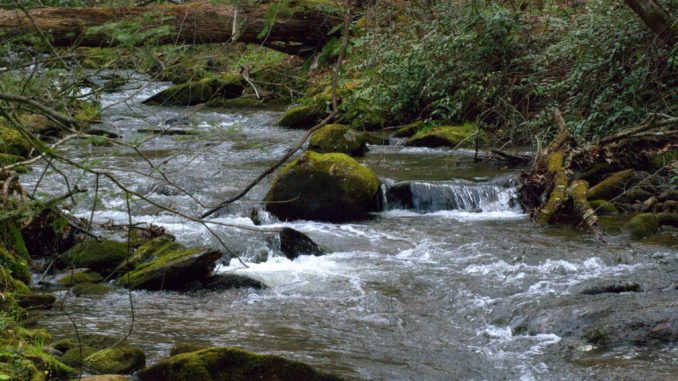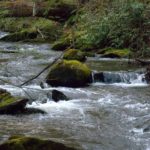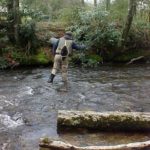
Terrestrials will be top producers in autumn
Before stepping into a stream and making my first cast, I pause for a minute or two and study the stream, looking for breaks in the stream flow, pockets of slow water next to rushing water, plunge pools, and other places where trout are likely to be. It’s called reading the water, something every good trout fisher does.
If I see a rock, log or clump of debris interrupting water flow, chances are very good that a trout is waiting behind the obstruction, watching for something edible to float by. Place a fly above the obstruction and let the water sweep it. If a trout is holding in that still water behind the obstruction, it will strike.
In hot weather, trout prefer the cooler sections of a stream. Overhung banks and shaded sections are more likely to produce a strike than open water. Plunge pools are ideal places in hot weather because the water is well-oxygenated. Usually, you’ll find a flume of swift water channeled into a pool; on each side of the flume are sections of quieter water. Cast to the section closest to you first, then to the far side. Trout seldom hold in swift water for any length of time. It’s not that they’re lazy, they just prefer to preserve their energy whenever possible.
This summer has been one of the hottest on record, with temperatures climbing into the 90s for weeks at a time, even in the high country. The hot weather hasn’t been good for trout or fishers. Low-lying streams without adequate canopy protection have suffered the most. Weather mavens predict that the high temperatures will continue into the fall, which, along with spring, is usually one of the two most productive times to fish for trout. If high temperatures persist, we’ll likely see fewer big trout next spring. Biologist say bigger trout have a slimmer chance of surviving hot weather than smaller ones. Makes you wonder if all the global warming predictions are true.
Earlier, I mentioned places where trout are likely to be. Let me emphasize “likely.” I was fishing with my son years ago on the Rocky Broad River. I was casting to one of those “likely” places without getting any results. My son was behind me, sweeping his bait back and forth through a shallow pool.
“You aren’t going to catch a fish that way,” I said. “You’re playing, not fishing.”
A few minutes later, he caught a fish. Trout aren’t always predictable.
Terrestrials will continue to be the primary flies for late summer and early fall fishing. This will be the rule until the first hard frost. Grasshoppers are especially numerous in late summer, providing plenty of protein for hungry trout. Best patterns are Dave’s Hopper, Letort Hopper, Parachute Hopper and Jack Cabe Hopper — difficult to find, but one of the best).
Other effective terrestrial patterns are floating or sinking inchworms, black ants, beetles, yellow jackets (the Tennessee Bee is an excellent imitation) and crickets. Size is best determined by the size of the insect the terrestrial is imitating — usually No. 8, 10 or 12. Primary dry-fly hatches are black or white Trico, Blue-Winged Olive and midges. Suggested sizes are No. 20 to 16. For the midges, you can drop as low as No. 26, if you have excellent eyesight.
Attractor patterns include Elk Hair Caddis, Adam Caddis, Peacock Caddis, Orange Palmer and Yellow Stimulator in Nos. 16 and 14. Suggested nymph patterns are Sheep Fly, Brown Stone and Blue-Winged Olive in sizes Nos. 10 and 12.
The N.C. Wildlife Resources Commission is proposing changes in regulations for trout streams throughout the western part of the state. Among the changes are reclassifying the upper Nantahala River and its tributaries on game lands in Macon County from wild-trout waters to wild-trout/natural bait waters; reclassifying 2.2 miles of Fires Creek in Clay County from wild-trout waters to delayed-harvest trout waters, and reclassifying 2.8 miles of Big Snowbird Creek in Graham County from hatchery-supported trout waters to delayed-harvest trout waters.
The Commission proposed adding delayed-harvest waters in Graham County when the program began but backed off when the proposal was soundly opposed by Graham County sportsmen and residents. Unless attitudes have drastically changed, the proposal likely will be opposed again.
The wild trout/natural bait designation was added when Bobby Setzer was District 9 commissioner to appease sportsmen in far-west counties who opposed the commission’s redesignation of national forest streams as wild-trout waters. After several contentious public hearings, the commission added the designation for several streams in Macon County, Cherokee County, Graham County, Haywood County, Jackson County, Madison County and Transylvania County. Creel and size limits are the same as for wild-trout waters. The only difference is that live bait (except fish) may be used.
The proposed changes will be presented at public hearings throughout the state in September.






Be the first to comment